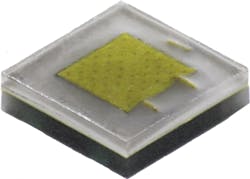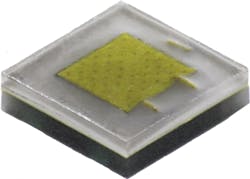The XLamp XP-L HI family of LEDs will target maximum candela through secondary optics while Cree is separately developing BSY plus red high-CRI arrays for ceramic metal halide replacement.
Cree has made two LED-centric announcements targeted at solid-state lighting product developments in vastly different application areas. The company has announced the XLamp XP-L HI (High Intensity) packaged LEDs that target applications ranging from indoor tracks to stadium lighting. Meanwhile, the company is demonstrating a new TrueWhite LED array or modular light engine, that will enable high-CRI, high-efficacy lighting products that can effectively replace ceramic metal-halide (CMH) lamps and later expand to serve other applications.
The new HI product series represents yet another way that Cree is positioning its packaged LEDs based on targeted application. Many of the announcements that Cree has made in the past year have featured what the company called high-density LEDs, whether the LED in question was in a discrete or a chip-on-board (COB) package. The high-density concept focused on maximum luminous flux relative to light-emitting surface (LES) and what Cree has called optical control factor.
Cree hasn’t previously used High Density or HD as a brand but will evidently do so going forward alongside HI. The HI packaged LEDs will be designed for "maximum candela through secondary optics," according to LED product development leader Paul Scheidt. Cree said the new LED can deliver 100,000 cd through a 50-mm lens at an operating power of 10W.
Primary optics architecture
The new XP-L HI LEDs use largely the same die as the previously announced XP-L products that will now be distinguished as XP-L HD. While the HD products have a primary optic in the form of a dome, the HI packaged LEDs have a near-flat primary optic.
The flat primary optic makes the image of the LES/die appear smaller to the secondary optics in a luminaire. The smaller effective size means that you can get higher intensity or cd levels through the same secondary optic. The science is based on the étendue limits in total internal reflection (TIR) optics that determine the width of a beam.
Scheidt compared the XP-L HI and HD LED performance when each is coupled with an off-the-shelf Carclo 10755R1 TIR optic. At center beam, the HD LED tops out at around 12,000 cd while the HI LED exceeds 25,000 cd. Scheidt said the closest competitive product from a source beside Cree performs worse than the HD LED and has a center-beam dip because the product uses multiple emitters and produces no light in the center of the LES.
The specifications on the new packaged LEDs mirror those of the original XP-L products. The LEDs come in a 3.45×3.45-mm package and Cree offers the products across the range from 2700K to greater than 5000K in CCT. At the warmer CCTs, 90 CRI is an option. The LEDs deliver 1095 lm maximum. That figure trails the 1226 lm of the HD version, but the HI characteristics match the intended usage.
Scheidt said the XP-L HI can be used as a direct replacement for XP-G2 LEDs. The XP-G2 has a smaller die, but the optic dome on the XP-G2 makes the LES image the same size as the XP-L HI with a larger die. Developers can use the same optics and achieve far greater energy in the center of the beam.
"The XP-L High Intensity LED looks like a great option for some of our upcoming lights," said Jon Quenzer, electrical engineer at Trek. "The XP-L High Intensity LED allows us to boost the efficacy and intensity of our XP-G2 LED based designs without changing optics or drivers."
TrueWhite arrays
Cree will demonstrate an LED array this week, intended as a building-block product for SSL developers, that includes a two-channel approach to achieving high CRI at a warm CCT. The product is essentially a printed-circuit board (PCB) with LEDs and some control circuitry but no on-board AC/DC driver or power supply. Cree also referred to the technology as lamp on board, but in all fairness it’s a modular light engine.
Cree will label the new array with the TrueWhite brand. TrueWhite is the brand that the company has long used in end-lighting products that achieve 90 CRI or better. The first such TrueWhite products used what has come to be called a BSY (blue-shifted yellow) plus red approach. Such implementations mix off-white and red LEDs to deliver warm-white light with efficacy that is higher than what can be achieved strictly through the use of warm-CCT phosphors. The BSY plus red technology dates to at least 2011 and early TrueWhite troffers.
The downside to the BSY plus red approach is the need for a two-channel LED design, and that is the reason that there is a control circuit on the new Cree PCB even though there is no full driver present. Cree has offered similar capabilities in modules such as LMH2+ that includes a basic skin around the module.
Scheidt said the two-channel approach will enable Cree to demonstrate a level of performance never achieved by LED sources in a form factor that can replace CMH lamps. The demo due this week will yield 140-lm/W efficacy, according to Scheidt, and output 3500 lm from 27W and a 19-mm LES. With a driver bringing the power level to 37W, Cree said the new array will significantly outperform a CMH product that dissipates 43W with the ballast while providing both better color rendering and higher center beam candle power (CBCP).
Scheidt said the first commercial arrays based on TrueWhite technology will be shipped by the end of summer. Ultimately, the company plans to build out a portfolio of light engines in different form factors and lumen packages.






